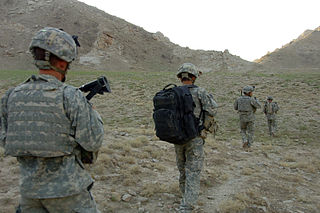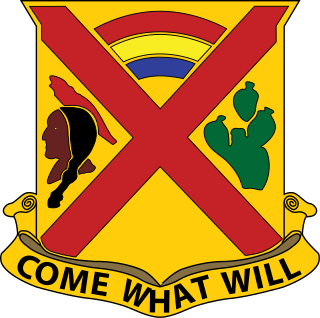
A long-range reconnaissance patrol, or LRRP, is a small, well-armed reconnaissance team that patrols deep in enemy-held territory.

Long-range surveillance (LRS) teams were elite, specially-trained surveillance units of the United States Army employed for clandestine operation by Military Intelligence for gathering direct human intelligence information deep within enemy territory. Classic LRS employment is to infiltrate deep into enemy territory, construct hide and surveillance sites, and provide continuous surveillance/special reconnaissance of an intelligence target of key interest.

The 9th Cavalry Regiment is a parent cavalry regiment of the United States Army. It is not related to the 9th Kansas Cavalry Regiment of the Union Army. Historically, it was one of the Army's four segregated African-American regiments and was part of what was known as the Buffalo Soldiers. The regiment saw combat during the Indian and Spanish–American Wars. During Westward Expansion, the regiment provided escort for the early western settlers and maintained peace on the American frontier.
Reconnaissance, surveillance, and target acquisition (RSTA) refers to a joint doctrine of reconnaissance, surveillance and target acquisition conducted by the United States Armed Forces. RSTA operations are designed to support military operations at a strategic, operational, or tactical level, either by dedicated RSTA forces or those which possess the capability.

United States Army Reconnaissance and Surveillance Leaders Course (RSLC) is a 29-day school designed on mastering reconnaissance fundamentals of officers and non-commissioned officers eligible for assignments to those units whose primary mission is to conduct reconnaissance and surveillance, target acquisition, and combat assessment operations. RSLC is taught by the 4th Ranger Training Battalion, Airborne and Ranger Training Brigade. The school is open to Soldiers, Marines, Sailors and Airmen to train them to expert levels in reconnaissance, surveillance, target acquisition, battle damage assessment, communications, planning, foreign vehicle identification, and other skills. The school was originally created to serve leaders from Long Range Surveillance Units (LRSU's), but now provides the specific reconnaissance training needed to ensure the effectiveness of small unit reconnaissance elements for the U.S. Army and joint force. Given the training focus and difficulty of the RSLC, the school is still commonly attended by operators from U.S. Army Special Forces, the 75th Ranger Regiment's Regimental Reconnaissance Company, U.S. Army Civil Affairs, Navy SEALs, and Marine reconnaissance units; today's students also come from more conventional infantry, Stryker and armored Brigade Combat Teams (BCT). Following the US Army decision to disband US Army LRS companies, the reconnaissance fundamentals taught in the course also provides U.S. military commanders the ability to preserve key LRS skills and abilities within the conventional force.

The 58th Expeditionary Military Intelligence Brigade is a military intelligence brigade of the United States Army National Guard in Maryland. It was largely formed from the personnel and equipment of the 58th Battlefield Surveillance Brigade and officially stood up in its present configuration on 1 August 2015. Most recently, members of the brigade joined state efforts to contain the spread of COVID-19 in Maryland and constituted one of the last U.S. Army National Guard units to serve in the War in Afghanistan, returning to Maryland in February, 2021.

The battlefield surveillance brigade (BfSB) was a United States Army surveillance/reconnaissance formation introduced from 2006 to 2015. The United States Army planned for the creation and transformation of nine intelligence brigades to a 'battlefield surveillance' role in 2007. The first battlefield surveillance brigade was deployed the same year conducting Surveillance, Reconnaissance and Intelligence (ISR) operations.
The United States Army long range surveillance detachment (LRSD) is organized as a detachment organic to the military intelligence battalion at division level for the purpose of long-range surveillance. The LRSD's are organized into a headquarters section, communications section, and six surveillance teams. The leaders are airborne and Ranger qualified. All other personnel in the detachment are airborne qualified. Most active Army LRSDs were inactivated in September 2005, with the notable exceptions 173rd Airborne's LRSD which was deactivated in 2006 and the 82nd Airborne's LRSD, which was converted to Pathfinders in 2008, and most Army National Guard units were inactivated in September 2008; some were transferred to battlefield surveillance brigades and were reflagged and redesignated as Troop C within the brigade's cavalry squadron. For example, the 151st Infantry Detachment (LRS) of the 38th Infantry Division became Troop C (LRS), 2d Squadron, 152d Cavalry Regiment, 219th Battlefield Surveillance Brigade. Two new National Guard Long Range Surveillance Companies were stood up in September 2009.

The 1st Squadron, 75th Cavalry Regiment is a United States Army cavalry squadron established in 2004. It is the Reconnaissance, Surveillance and Target Acquisition Squadron (RSTA) squadron of the 2nd Brigade Combat Team "Strike" ♥, 101st Airborne Division, and performs reconnaissance and cavalry missions in support of that brigade.

Special reconnaissance (SR) is conducted by small units of highly trained military personnel, usually from special forces units or military intelligence organizations, who operate behind enemy lines, avoiding direct combat and detection by the enemy. As a role, SR is distinct from commando operations, but both are often carried out by the same units. The SR role frequently includes covert direction of airstrikes and indirect fires, in areas deep behind enemy lines, placement of remotely monitored sensors, and preparations for other special forces. Like other special forces, SR units may also carry out direct action and unconventional warfare, including guerrilla operations.

In the United States (US) Department of Defense, a beret flash is a shield-shaped embroidered cloth that is 2.25 in (5.72 cm) tall and 1.875 in (4.76 cm) wide with a semi–circular base that is attached to a stiffener backing of a military beret. These flashes—a British word for colorful cloth patches attached to military berets—are worn over the left eye with the excess cloth of the beret shaped, folded, and pulled over the right ear giving it a distinctive appearance. The embroidered designs of the Army's beret flashes represent the heraldic colors and patterns of a unit with a unique mission or represent the Army overall. The Air Force's beret flashes represent their Air Force Specialty Code (AFSC) or their assignment to a unit with a unique mission. Joint beret flashes—such as those worn by the Joint Communications Support Element and the Multinational Force and Observers—are worn by all who are assigned, given their uniform regulations allow.

The 201st Expeditionary Military Intelligence Brigade is located at Joint Base Lewis-McChord, Washington. The 201st was originally named the 201st Military Intelligence Brigade and on 3 July 2008 it became the Army's third active duty battlefield surveillance brigade and was renamed the 201st Battlefield Surveillance Brigade (BfSB). The US Army decided to get rid of its BfSBs and the 201st was realigned into a new expeditionary military intelligence brigade.

The 504th Military Intelligence Brigade is located at Fort Hood, Texas. The brigade is tasked to improve the situational awareness for commanders at division level or higher, so they can adapt their units combat power for the current operations. For this the Military Intelligence Brigades can deploy unmanned aerial vehicles, signals gathering equipment, human intelligence collectors and long range surveillance patrols. From 2007 to 2015 the 504th served as an expeditionary military intelligence brigade (EMIB) becoming one of three active duty Surveillance Brigades of the United States Army. In 2015, the brigade returned to its original name and mission as the 504th Military Intelligence Brigade conducting intelligence, surveillance, and reconnaissance in support of III Armored Corps.

The 51st Infantry Regiment is a regiment of the United States Army first established in 1917.

The 219th Battlefield Surveillance Brigade was part of the United States Army Surveillance/reconnaissance formation introduced from c.2006-2011. The United States Army planned for the creation and transformation of nine intelligence brigades to a 'Battlefield Surveillance' role in 2007. The first Battlefield Surveillance Brigade (BfSB) was deployed the same year conducting Surveillance, Reconnaissance and Intelligence operations. However, gathering information is only half the challenge it faced. Along with the structural changes and intelligence capabilities, the sustainment capabilities of the brigade also changed.[2] The United States Army reorganized it’s intelligence formations into Battlefield Surveillance Brigades (BfSB). The brigades were self-sufficient Army Modular Forces. Army doctrine changed the name of the BfSB to Reconnaissance and Surveillance Brigade in 2011. In 2016, the 219th BfSB was redesignated to the 219th Engineer Brigade.

The 3rd Squadron (R&S), 108th Cavalry Regiment was the reconnaissance and surveillance element of the 560th Battlefield Surveillance Brigade of the Georgia Army National Guard. The squadron was headquartered in Atlanta, Georgia. Nicknamed Renegades, it consisted of:

The 71st Expeditionary Military Intelligence Brigade (EMIB) is a unit of the Texas Army National Guard.

The 525th Expeditionary Military Intelligence Brigade (Expeditionary) is a unit of the United States Army specializing in the acquisition and analysis of information with potential military value. On 28 October 2014, the unit was reflagged from the "525th Battlefield Surveillance Brigade" to an expeditionary military intelligence brigade, the first of its kind.

The 142nd Battlefield Surveillance Brigade was located at Decatur, Alabama. The 142nd BfSB was a Major Command (MACOM) of the Alabama Army National Guard.
















